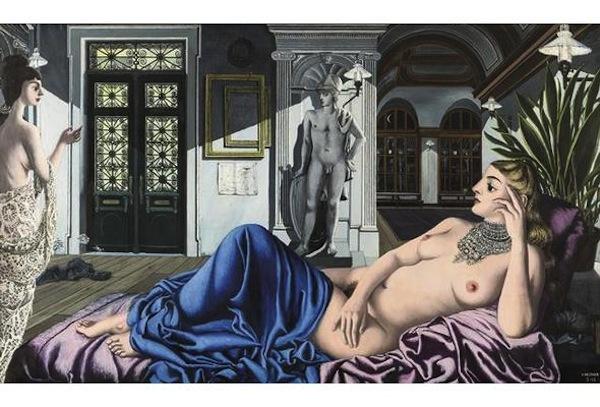Blain|Di Donna are presenting an exhibition of paintings and drawings by the Belgian artist Paul Delvaux. Curated in close collaboration with the Paul Delvaux Foundation, it brings together over twenty oil paintings and works on paper that date from the mid-1930s to the mid-1960s, and is the first ever solo show of the artist’s work in the United Kingdom.
This exhibition is comprised of loans from the Paul Delvaux Foundation, European museums and important private collections and it will be coming to London from Blain|Di Donna in New York, where it is on view until June 1, 2013. It is the fourth major monographic exhibition staged by Blain|Di Donna dedicated to revisiting the oeuvre of Surrealist masters, being preceded by presentations of René Magritte, André Masson and Jean Arp.
Delvaux, like his compatriot René Magritte, was profoundly influenced by the enigmas proposed by Giorgio de Chirico’s earlier metaphysical works and the fantastical works of James Ensor. Although never directly associating himself with the Surrealist movement, Delvaux set forth similar dreamlike compositions within his paintings, being nonetheless deeply moved by the ideas of its protagonists. Throughout his life, Delvaux retained a strong respect for the Classical world and embraced it by curiously merging traditional Renaissance perspective, a rekindling of Ingres’s voluptuous nudes, Greek and Roman architecture and their subsequent ruins, with a modernized Belgium of street cars, suburban personages and whimsical characters from Jules Verne’s illustrated novels, thus creating a mysterious theatre of the absurd.
Delvaux’s paintings of the late-1930s are often set upon a constructed stage of strange and desolate landscapes; dramatic mountains rising into the distance, defined through strong contrasts of light and dark. In Le récitant (1937), a seemingly hypnotised, half-undressed man points towards a painting within a painting, where a fertile green composition potent with symbols of female sexuality is juxtaposed against the surrounding arid environment, where another unclothed male figure wanders towards nothingness.
On loan from the Musée d’Ixelles in Belgium is La fenêtre (1936), an early masterpiece which presents a female figure, in profil perdu, standing on a shallow balcony with windows opening onto the interior. However in a typical Surrealist manner a sense of the uncanny pervades our logical reading of space. The building’s interior is replaced by a verdant landscape which recedes into bluish hills reminiscent of Italian Renaissance painting. Our view is from the street upon the detailed building’s façade of ashlars and ironwork and continues vis-à-vis the figure’s gaze onto the wide open landscape.
His works of the 1940s — while becoming more preoccupied with stylistic representation upon the picture plane and less concerned with perspective — continue to utilise the sensual language that characterised Delvaux’s work throughout his career. Surrounded by sumptuous silk and velvet fabrics, wide-eyed and voluptuous naked women assume reclined positions, suggesting a pictorial rhetoric of seduction and temptation. Studying architecture at the Académie Royale des Beaux-Arts in Brussels before becoming a painter, Delvaux ensures that space and setting plays an important role within these works, as in the monumental L’éloge de la mélancolie (1948), where a post-coital nude lies within the grand interior of a classically-designed home.
The formal qualities of Delvaux’s work continued to develop into the 1950s and 1960s, where he depicted nightscenes with the moon beaming into dark and ominous skies. In Le sabbat (1962), clothed and unclothed figures surrounded by trees and candlelight occupy the composition, creating a mise en scène within which an eerie and erotic narrative is suggested. A clothed man addresses his own reflection in a gilded mirror, his glazed circular spectacles obscuring his eyes and echoing the dark, hollowed gazes of the women within the painting.
Paul Delvaux (1897–1994) was a Belgian Surrealist painter born in Antheit in the province of Liège. His early studies in architecture at the Académie Royale des Beaux-Arts de Belgique left an indelible impression upon his paintings, where figures often populate urban settings within a traditional perspectival space. Delvaux’s oeuvre consists primarily of repeating female nudes, suited men, trains and street cars, set in the everyday life of Belgian suburbia or mysterious classical ruins. In 1965 he was named director of the Académie Royale de Belgique. Important exhibitions during his lifetime include both the 1948, 1954 and 1968 Venice Biennials and major retrospectives in 1973 in the Boijmans Van Beuningen Museum in Rotterdam, and then in 1997 at the Musée Royaux des Beaux-Arts de Belgique.
Paul Delvaux: Blain Di Donna 6 Hill Street London, W1J 5NF 18 JUNE – 17 JULY 2013

